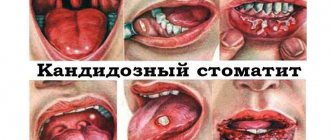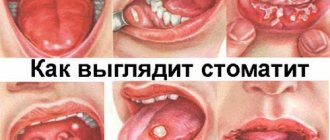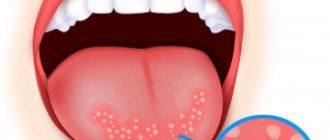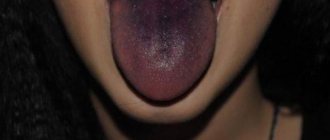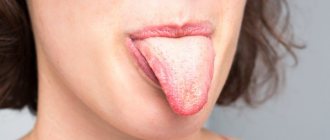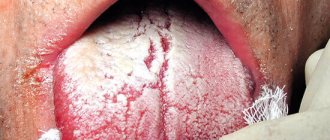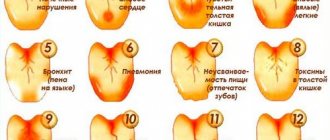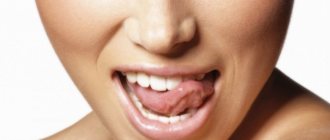The appearance of a white coating on the tongue does not surprise anyone. And often people do not even realize that this symptom may indicate the presence of dangerous diseases. Why a white tongue appears in an adult, the causes and treatment of this condition are described in the review below.
In what cases is a white tongue normal, and in what cases is it pathological?
The initial examination at home should be carried out before brushing your teeth and eating. It is advisable to carry out such procedures on an empty stomach, immediately after waking up. Don't panic if a white film appears on your tongue. She does not always talk about problems in the body.
Health-wise, everything is normal if the tongue is quite moist, the color is pale pink and there is no increase in size, and deposits are easily cleaned off.
The following symptoms will indicate that the body is not working as it should:
- swelling of the tongue, changes in its size and the appearance of teeth marks;
- the presence of burning, soreness and sensitivity of the tongue;
- increased salivation, or, conversely, severe dry mouth;
- difficult to remove dense film;
- the appearance of large papillae near the root of the tongue;
- foul odor from the mouth;
- significant increase in white deposits.
If you notice these symptoms, you should monitor your tongue for a week. If no positive changes appear during this time, it is recommended to consult a therapist. An experienced specialist knows how to get rid of white plaque on the tongue of adults and children.
The doctor will carry out diagnostic procedures and, if necessary, refer you to specialists for diagnostics. Depending on the reasons that caused the occurrence of such a symptom in an adult, you will need the help of an infectious disease specialist, gastroenterologist, endocrinologist or other doctors.
When there is a coating on the tongue of an adult - this is normal
Before understanding the causes of symptoms and methods of treating diseases, you need to figure out whether you should worry at all, because sometimes such a whitish layer can be a variant of the norm.
To assess whether or not there is a white coating on the tongue of an adult in the morning, stand in front of a mirror, open your mouth wide and stick out your tongue as much as possible. It is necessary that you see both the root of your tongue and your tonsil.
Next, pay attention to 5 criteria: structure, color, presence of formations, smell and taste. Normally, a healthy adult’s tongue should be pink, slightly velvety in texture, moist, and the papillae should have the correct structure. There should be no sores, blisters, unpleasant odor or taste that do not disappear after cleaning. A small white coating may be present, which is easily detected and does not appear again after that.
But if you have the following signs, this may indicate emerging health problems:
- the tongue swells overnight, and in the morning teeth marks become visible on it;
- the color changes from pink to gray-white, and red spots appear along the edges;
- excessive dryness appears;
- the papillae increase in size and become more like pimples, especially in the root area;
- sensitivity is impaired;
- an unpleasant odor that remains even after cleaning and a burning sensation;
- the plaque is not completely removed during morning procedures.
What does the localization of a white veil on the tongue indicate?
Not everyone knows that the causes of white plaque on the tongue can be determined by its location. Such symptoms may appear.
In the central part - such localization indicates pathological problems in the stomach, so an adult patient will definitely need treatment from a gastroenterologist. This symptom may indicate gastritis or an ulcer.
A gastrointestinal disease is at the very beginning of development if the pink membrane is visible through the white surface.
The base - the area in the middle of the tongue corresponds to the intestines, and the area at the edges - to the genitourinary system.
On the sides - in this case we can talk about lung diseases. In this case, first of all, you should adjust your diet, which should include a sufficient amount of proteins, carbohydrates and fats.
Closer to the root of the tongue - most often this condition indicates urological problems. In this case, it is advisable to contact a nephrologist and undergo kidney treatment.
If the tongue is covered with a thin and light film, and there is very little of it, then there is nothing to worry about. An adult should sound the alarm when the entire surface of this organ is under a thick layer of white film. In such a situation, a mandatory consultation with a doctor and subsequent treatment are necessary.
Gastrointestinal pathologies
The body reacts very quickly to pathological changes in the stomach and intestines. An imbalance in such systems leads to the formation of a white film on the tongue of an adult, as well as the appearance of belching and a foul odor. The following are ailments that can cause this condition:
Gastric ulcer . This disease is accompanied by a coating of the tongue with a whitish layer with a gray tint. When an ulcer occurs, it appears on its root area and is very difficult to remove. In addition, a burning sensation in the stomach, nausea and hunger pain may occur.
Pancreatitis . In this case, the mucous membrane on the palate and on the inside of the cheeks becomes dry, and there is also severe pain under the left rib. As for the tongue, it acquires a white-yellow tint. If pancreatitis is chronic, the patient may develop dense white deposits all over the tongue.
Oncological diseases . The condition is accompanied by a very dense whitish film that has a foul odor. The edges are clean.
Gastritis . With this disease, a film of white-yellow or white-gray color appears. If the disease occurs in an acute form, intestinal disorders and nausea may appear, sometimes progressing to vomiting. In addition, dry mouth often occurs due to water imbalance and pain in the epigastric region.
In addition to the reasons listed, this sign may be evidence of gallbladder pathologies and liver problems. For example, a yellowish or whitish color is a sign of dysbiosis. Only a specialist can tell you how to get rid of white plaque on the tongue and what treatment an adult will need.
If there is bad breath
A white coating on a child's tongue is sometimes accompanied by bad breath. The combination of these symptoms should alert parents. You can try to solve the problem yourself, but it is better to consult a doctor - seemingly minor signs may indicate the onset of serious illnesses. The most common causes of white coating on the tongue and bad breath lie in various diseases of the gastrointestinal tract.
Caries and stomatitis
It is not always possible to independently detect caries in a child without special equipment and the “watchful eye” of a dentist. Therefore, if suspicious symptoms are detected in a child, it is recommended to visit a specialist. Even very young children may develop a pronounced sour breath and a white coating on the tongue - symptoms of candidal stomatitis . There is no need to worry - this is not an indicator of the baby’s serious ill health. The best remedy in such a situation is a soda solution, which is recommended to lubricate the affected areas. At the age of 2-3 years, most children first encounter the herpes virus and Epstein-Barr. When they are initially affected, blisters and redness appear in the mouth, including on the tongue, which hurt and bother children. These symptoms may be accompanied by bad breath, especially if a bacterial infection is associated with poor hygiene. The favorite pastime of all children is to taste an object, and as a result, bacterial stomatitis often occurs in children. The formation of ulcers with a gray-white coating on the tongue, palate, cheeks, and an unpleasant putrid odor from the mouth are its main symptoms.
Diseases of other parts of the gastrointestinal tract
The color of a child's tongue and the smell of his breath reflect the state of his gastrointestinal tract (GIT). That is why the first thing any doctor asks you to show during an examination is your tongue. With gastrointestinal dysfunction, the surface of the tongue becomes covered with a gray or white-gray coating, which is easily removed with a gauze swab or toothbrush.
As for the smell from the mouth, it can be putrid, ammonia-like, or similar to the smell of a “rotten” egg. To establish the exact cause and prescribe effective treatment, additional examination is almost always necessary, so you cannot do without a doctor. Diseases that cause these symptoms:
Acute or chronic gastritis (with high, low or normal acidity). Gastric ulcer. Foreign body in the stomach or intestines. This often happens when you regularly swallow small particles, such as cat hair or hair, which gradually accumulate in the stomach. Treatment in this case is only surgical.
Other diseases
Diabetes. Bad breath is caused by exhaling air containing acetone vapor, which is formed in the body when the absorption of blood glucose is impaired. The surface of the tongue may also become covered with a gray-white coating with an unpleasant odor of acetone. Other symptoms of diabetes : increased blood glucose levels, increased sweating, weakness, fatigue. Chronic tonsillitis. As a result of chronic inflammation, yellowish plugs form on the palatine tonsils in children, a large number of which can give a slight putrid odor from the mouth and a yellowish coating on the root of the tongue. Other symptoms of tonsillitis : frequent exacerbations with the appearance of sore throat symptoms.
Infectious diseases
This symptom may indicate the presence of an infection. Below are the most common diseases in which a similar symptom appears:
Thrush . This disease occurs due to the Candida fungus growing in the mouth. In this case, a white film similar to a curd mass is formed. This symptom is accompanied by severe itching and burning in the mouth.
Among other things, this condition can cause the appearance of microcracks in the mucous membrane of the oral cavity.
Stomatitis. This infectious disease of the oral mucosa looks like swollen gums with small ulcerations. In addition, a grayish coating may occur on the inner parts of the cheeks.
Gonorrhea . This disease is transmitted sexually and is difficult to treat. A white film appears not only on the tongue, but also on the palate.
The causes of plaque on the tongue may not only be of an infectious nature. This condition can be caused by helminths, which are very easy to become infected, for example, through unwashed fruit.
This disease manifests itself in all parts of the mouth. In this case, a yellowish-white film appears, localized on the palate and on the inside of the cheeks.
Among other things, it is recommended to pay attention to serious diseases that may affect other organs (for example, tonsillitis, whooping cough, diphtheria, etc.) With such ailments, a white coating forms on the root of the tongue.
White coating on the tongue with a sore throat – City Clinic No. 2 of the State Budgetary Healthcare Institution of the Novosibirsk Region
- White coating on the tongue combined with a sore throat occurs for many reasons .
- The most common of them are bacterial and fungal infections of the oral cavity , but there are a number of other factors that provoke this condition.
- What accompanying symptoms may occur if there is a white coating on the tongue and in what cases should you consult a doctor?
Know! How is diagnosis carried out and what treatment methods are available depending on the causes of the pathology? We'll figure it out in the article.
Possible reasons
Possible causes of the appearance of white plaque in combination with a sore throat include the following factors:
Minor injuries and any other damage to the tongue
For example, a person accidentally cuts his tongue with a fork or toothpick, and pathogenic bacteria penetrate through the damaged tissue, causing inflammation.
Long-term use of any medications
If a person has been taking antibiotics, steroids or other drugs for a long time , such symptoms may appear.
Hormonal disorders in the body
In women, this can happen during menopause.
Associated symptoms in this case: burning and dry mouth, increased sweating.
Gastrointestinal pathologies
Stay up to date! This can be gastritis with low or high acidity, stomach and duodenal ulcers, colitis or enterocolitis, etc.
Diseases of the digestive tract are usually accompanied by symptoms such as abdominal pain, nausea, constipation or diarrhea, and heartburn.
Inflammation of the gallbladder
Associated symptoms: pain in the lower abdomen (on the right side), dry mouth, high fever.
Infectious diseases
- Among them are dysentery, scarlet fever, diphtheria, immunodeficiency virus and others.
- Infections, as a rule, are not limited to just plaque and sore throat.
- Usually accompanied by the following symptoms: body temperature above 38-39 degrees, muscle pain and aches, skin rash, diarrhea, vomiting.
Diseases of the throat and oral cavity
Keep in mind! As a rule, tonsillitis, tonsillitis, pharyngitis, stomatitis are characterized by such symptoms.
This may increase body temperature (in some cases) and cause weakness in the body . There may also be problems with swallowing food, burning and dry mouth, hoarseness in the voice, etc.
Viral infections
This is the flu, ARVI .
Associated symptoms: high fever, headache, cough, runny nose, body aches.
Oral candidiasis
This is usually a fungal infection of the mouth.
The disease most often occurs in young children and is accompanied by severe pain, burning and dry mouth.
Note! In this case, a white, cheesy coating is observed not only on the tongue, but also on the lips and the inside of the cheeks.
Glossitis
This is an inflammation of the tongue caused by injury or exposure to pathogenic microorganisms.
Oral leukoplakia
- A disease of the mucous membrane of non-infectious etiology, in which white thickenings form on the gums, tongue and inner surface of the cheeks .
- According to Ayurveda, the tongue is divided into several parts, each of which is responsible for a particular organ.
- Therefore, plaque on the front of the tongue indicates problems with the heart and liver, and near the root - intestinal pathologies.
- If deposits are in the central part, they indicate a dysfunction of the spleen, stomach and pancreas.
It is worth noting! Formations in the lateral part (both on the left and on the right side) indicate problems with the kidneys.
Associated symptoms
White coating on the tongue is usually accompanied by the following symptoms:
- burning and dry mouth;
- increased thirst;
- increased body temperature;
- heartburn and belching;
- bad breath;
- muscle weakness and causeless fatigue;
- severe sore throat, aggravated by eating;
- craving for sweets (one of the signs of candidiasis);
- irritable bowel syndrome (diarrhea, pain, etc.) and bloating.
You should know! At the same time, some of the accompanying symptoms may be absent in certain cases (depending on the underlying disease - the root cause of the appearance of white plaque).
In what case should you consult a doctor and undergo an examination?
The following signs are reasons to consult a doctor:
- The presence of a dense, cheesy plaque , which is not removed when brushing the teeth and mouth or quickly appears again.
- Edema and swelling of the tongue.
- Bad breath .
- Pain and burning in the abdomen , eating disorders.
- Presence of small ulcers in the mouth .
- Rash on the face and body.
- Impaired taste sensitivity.
- Dryness and burning in the mouth.
- High body temperature.
- Constant weakness and lack of energy.
Remember! All of the above symptoms should be a cause for concern and immediate consultation with a doctor (ENT specialist, therapist, dentist or gastroenterologist).
Diagnostics
- After a visual examination of the oral cavity and analysis of the patient’s complaints, the patient is sent for a general blood test and a mouth smear for bacterial culture (bacteriological culture).
- Next, based on the results of the studies, the patient is referred to the appropriate specialist.
- It depends on the underlying disease and then treatment is prescribed.
- But if gastrointestinal diseases or hormonal disorders are suspected, are prescribed by appropriate specialists.
Treatment
For your information! In certain cases, treatment may differ radically (based on the root cause of the appearance of white plaque).
So, depending on the underlying pathology, the patient is prescribed the following treatment:
- In case of problems with the gastrointestinal tract the diet is , excluding all harmful foods from the diet. First of all, fatty meat, fried foods, fast food. This also includes sour cream, butter, alcohol and sweet carbonated drinks. Prescribe medications appropriate to the current disease. The treatment is carried out by a gastroenterologist.
- For influenza and ARVI, antipyretics (Paracetamol, Ibuprofen, etc.) and drugs for topical use are prescribed Among them, nasal drops - Naphthyzin, Xylometazoline, Otrivin, etc.; tablets and lozenges for resorption with anti-inflammatory action - Doctor Mom, Strepsils, etc.
- In case of fungal infection of the oral cavity , the patient is prescribed antifungal drugs. Among them: Rumicosis, Fungicidin, Diflucan, Nystatin, etc.
- If you have a sore throat and other throat diseases , medications such as Faringosept, Ingalipt, Neo-angin, Septolete, etc. Antiseptics (Miramistin and Chlorhexidine), Furacilin solution (1 tablet per glass of warm water) are prescribed as rinses. You can use soda-salt solution (1 teaspoon of each per glass of warm water). Decoctions of chamomile, sage, and calendula are also suitable (1 tablespoon of raw material per glass of boiling water).
- For bacterial infections , oral antibiotics are indicated (Sumamed, Amoxiclav, Cephalexin, Azitrox, etc.). In this case, it is necessary to complete the full course of treatment. Even if the symptoms go away a few days after starting therapy.
- For glossitis , first of all, it is necessary to exclude hot and spicy foods from the diet. Remove from the diet too salty, with the addition of red or black pepper, garlic, onion, mustard, various sauces, etc. And it is important to rinse your mouth with Chlorhexidine, Miramistin, a weak solution of potassium permanganate, Furacilin, herbal infusions, etc. .
- In case of hormonal disorders , treatment is carried out by an endocrinologist. The course of treatment and dosage of certain medications is prescribed by the doctor. Self-medication is unacceptable, because without knowing the true cause of the plaque, therapy will be meaningless and can only aggravate the situation.
conclusions
Important! In conclusion, it is worth noting that:
- A white coating on the tongue (especially of a dense consistency) and a sore throat are just some of the symptoms of some disease. Therefore, it is important to contact a medical facility and undergo the appropriate tests. After this, it will become clear in which direction to organize therapy.
- Oral fungus is especially dangerous, since you can inadvertently infect other people, be it family members or work colleagues.
- No less dangerous are gastrointestinal diseases and viral infections (they can obviously be tracked by accompanying symptoms). Indeed, in the absence of timely treatment, they quickly progress and worsen the patient’s condition.
- During the treatment process, you must follow all the doctor’s instructions and not deviate from the prescribed course of therapy.
Source:
Sore throat or not? What does white plaque on the tonsils mean?
White plaque on the tonsils indicates the accumulation of pus. In 80% of cases, this is observed after ARVI, tonsillitis or pharyngitis. The deposits themselves are not a pathology, but require immediate medical intervention.
When is it not worth worrying?
White plaque on the tonsils sometimes appears due to the consumption of fermented milk products. In this situation, it is enough to rinse your mouth and wash away the deposits.
Sometimes a person, in a hurry or through negligence, injures the tonsils themselves, or the nearby mucous membranes. This happens when he eats too hard food, drinks very hot drinks, or accidentally swallows a fish bone.
A strong immune system quickly copes with the damage, and the wound gradually heals.
Otherwise, suppuration develops, and the person requires prompt medical intervention.
Common Causes
The main reasons for the appearance of a white layer on the tonsils are presented in the table:
CauseDescriptionAdditional symptoms
| Acute tonsillitis (purulent tonsillitis) | Damage to the upper respiratory tract, characterized by the penetration of viruses or bacteria into the body. | White plaque with sore throat is combined with redness of the palatine arches. “Plugs”—caseous masses—appear inside the tonsils. A person has a severe sore throat, and the submandibular lymph nodes are enlarged. There is a soreness and burning sensation in the throat. The general temperature rises to 37-38 degrees. Against this background, there is severe pain in the joints and chills appear. |
| Pharyngitis | An inflammatory process affecting the mucous membrane and lymphoid tissue of the pharynx. | White plaque on the tonsils is present on the left and right at the same time. It is accompanied by a feeling that a foreign object is stuck in the throat. This feeling intensifies during swallowing. Dry mouth appears, which is combined with a sensation of tickling, burning and soreness. The submandibular and occipital lymph nodes are enlarged. When you press them, a pain syndrome appears. |
| ARVI | A group of acute inflammatory pathologies of the respiratory system. Provocateurs are pneumotropic viruses. | White plaque on the tonsils is present on both one and both sides. Against the background of increased temperature, aches in the joints appear and headaches are present. There is a runny nose and a severe cough that does not go away for a long time. |
| Simanovsky-Vincent's tonsillitis (ulcerative membranous tonsillitis) | Acute inflammatory process affecting the palatine tonsils. The provocateur is the Plaut-Vincent wand. | The main symptom is a white coating on the tonsils with fever. It appears on the 3rd day of illness. After 4-5 days it peels off on its own. In its place, a specific spot appears, which looks like a crater-shaped ulcer with clear but uneven edges. The maxillary lymph nodes increase to 1.5 cm. Swallowing becomes difficult, there is a sore throat (usually on one side), and salivation increases. |
Source: https://clinica2.ru/otoskleroz/belyj-nalet-na-yazyke-pri-bolnom-gorle.html
Diagnostics
It is recommended to contact a medical facility if, in addition to a white film, the following symptoms are present on the tongue of an adult:
- severe discomfort in the gastrointestinal tract;
- increased body temperature;
- diarrhea or constipation;
- rashes on the skin;
- muscle pain;
- numbness of the limbs;
- nausea, sometimes turning into vomiting;
- constant fatigue;
- fast fatiguability.
If the discomfort is localized in the mouth, you should visit a dentist. The dentist will identify dental diseases and, if necessary, refer you to other doctors to find out the reasons. Ultrasound diagnostics, stool, urine, and blood tests may be required.
Experienced specialists, based on the diagnosis, will tell you what plaque on the tongue means and prescribe treatment.
Sore throat and white coating on the tongue: causes and treatment, as well as accompanying symptoms
White coating on the tongue combined with a sore throat occurs for many reasons .
The most common of them are bacterial and fungal infections of the oral cavity , but there are a number of other factors that provoke this condition.
What accompanying symptoms may occur if there is a white coating on the tongue and in what cases should you consult a doctor?
Know! How is diagnosis carried out and what treatment methods are available depending on the causes of the pathology? We'll figure it out in the article.
What does the tone of the tongue say?
A yellowish tint can also indicate problems in the digestive organs. Basically, if a film of this color appears on the root of the tongue, the most likely cause is the accumulation of toxins in the colon.
To get rid of plaque on the tongue of an adult caused by this reason, you should briefly give up unhealthy foods, such as chips and crackers. You should remove sweet carbonated drinks with dyes from your diet. It is recommended to drink clean water, which will flush toxins from the body.
If a dense white layer has formed in the mouth of an adult that cannot be cleaned, the reasons may lie in chronic diseases of various types.
This condition often occurs as a result of taking antibiotics. The doctor will tell you how to get rid of plaque on the patient’s tongue and what medications should be taken.
A very dark film closer to a brown or grayish tone is formed by lovers of cigarettes, strong tea and coffee. But the reasons that cause this symptom may not be so harmless. In some cases, this may be a sign of dehydration that appears after serious illness.
To cope with such a condition, it is necessary first of all to establish a drinking regime. In addition, it is recommended to contact a medical facility, where a specialist will recommend effective remedies to replenish the loss of nutrients in the body.
Crohn's disease is very dangerous and unpleasant in its manifestations, occurring in less than a fifth of the world's population. The fact that this disease has appeared is indicated by inclusions of brown spots on the white film that covers the tongue.
Plaque of different shades
In addition to white, coatings with other shades may form on the tongue.
Yellow, like white, also indicates problems with the digestive organs. If the yellow film is localized at the root of the tongue, this is a sign that a lot of toxins have accumulated in the intestines. If the layer is dense, this indicates chronic problems. A yellow coating may accompany a sore throat.
Taking antibiotics can also cause a yellow or white coating on the tongue. As a rule, during their use, dysbacteriosis appears, which causes a yellow tint.
Dark deposits are common if you like coffee, strong tea and cigarettes. It can be light gray or closer to a dark shade. Also, a dark brown coating layer can appear with severe dehydration, at high temperatures. Crohn's disease (inflammation of various parts of the digestive tract) can cause brown patches of plaque on the tongue.
Treatment of white tongue with traditional methods
There are a large number of recipes from traditional medicine that can cope with the causes of this condition. They are used to treat white plaque on the tongue.
Gargling with infusion of plants
To do this, you will need medicinal herbs, which you need to take in equal proportions (1 tbsp each). Chamomile, sage and calendula work best. Place them at the bottom of the thermos and fill with 2 cups of boiling water.
Close the lid tightly and leave to steep for 5-6 hours. After this, the medicinal mixture must be filtered and rinsed in the mouth. It is best to carry out a similar procedure in adults every day until the whiteness goes away.
Rinse with oak bark decoction
How to get rid of plaque on the tongue in this way? To do this, you need to take half a glass of this crushed raw material and boil it in two liters of water. It is recommended to do this until a light brown tint appears. The homemade medicine is then cooled, strained and used as a rinse.
This treatment should be carried out 4 to 6 times a day. Oak bark decoction contains a large amount of tannins with an antiseptic effect, which help cope with the white film.
The reasons for the appearance of such a symptom can be very diverse. It should be borne in mind that a routine examination of the oral cavity will not give accurate results. An accurate diagnosis will be required, including instrumental, laboratory and physical methods. There is no need to worry, as doctors generally give favorable prognoses. They say that most often the white film does not appear due to serious illnesses, but is a consequence of poor nutrition or lack of oral hygiene.
White coating in the throat
Healthy throat mucosa has a pinkish tint. The appearance of a white coating in the throat is not normal. First of all, this is a sign of an infectious disease. White plaque on the throat requires immediate analysis of the cause of the anomaly. It is equally important to take suitable preventive measures.
Causes of plaque
Most often, white spots form on the tonsils. The process of their occurrence is that when pathogenic bacteria penetrate the mucous membranes, the body’s susceptibility is triggered. The body's immune functions respond to the emerging danger and destroy the onset of bacteria, resulting in a white coating on the back of the throat.
It is important to understand the root causes of an emerging infection in time to obtain effective treatment. In this case, subsequent infection in the bronchi and lungs can be avoided.
The reasons may be the following:
1. Sore throat. In the case of this disease, white spots appear at the initial stage of the disease. The spots that appear may be yellow.
2. Hygienic reasons. A whitish film may appear due to non-compliance with hygienic rules for maintaining the oral cavity. After eating, be sure to rinse your mouth and brush your teeth.
3. Diphtheria. You may encounter the disease less often, but you shouldn’t rule it out. With this disease, the patient has a red throat with a white coating. The plaque is quite difficult to remove, so blood clots may be released. With the disease, an increase in temperature in an adult, swelling of the tonsils, and headaches are observed.
4. Leukoplakia. This type of plaque occurs in tobacco smokers. White spots are noticeable in the throat. The temperature does not rise. The spots are formed by dying mucosal cells. Only a specialist can make an accurate diagnosis. The reasons may be completely different.
5. Candidiasis. Children may have this disease due to weakened immunity. This type covers the entire oral cavity. A white coating appears in the throat and on the tonsils, but it does not bother the child at all.
6. Syphilis. It can be seen very rarely, but the disease should not be completely ruled out. White spots appear on the back wall of the throat. This symptom occurs already in the case of a severe stage of the disease.
7. Scarlet fever. With this disease, a white film appears on the larynx, but this is not the most unpleasant sign. Scarlet fever is accompanied by fever, pain in the head and throat. If this cause is identified in a timely manner, the multiplying bacteria can be quickly dealt with.
8. Stomatitis. White coating on the tongue occurs without an increase in body temperature. White plaque in a child’s throat appears with more severe symptoms. There is a significant increase in body temperature.
9. Pharyngitis. A white coating appears in the throat without fever. Painful sensations may occur. There is often pain when swallowing food.
There are many diseases that can cause whitish spots to appear. But the main reason is reduced human immunity.
Without an increased temperature, the symptom may occur for the following reasons:
after a burn or injury;
· along with the personal characteristics of the organism;
· with a fungal infection;
· at the initial stage of development of any infection.
Localization and specificity
Where can plaque concentrations most often be observed? The most favorite places for the location of white plaque are the recesses of the tonsils. It is in such folds that food debris and pathogenic microorganisms accumulate.
The proliferation of such microorganisms leads to the development of purulent processes and the appearance of white plaque.
Plaque can also appear on the tonsils themselves in the form of a cheesy mass.
If this plaque can be easily removed with a cotton swab, then the cause is the activity of a fungus.
In the case of a whitish coating on the back of the throat, the problem is pharyngitis. As the disease progresses, the entire surface of the oropharynx becomes infected. If the plaque is in the form of a whitish mesh, then this indicates an autoimmune process.
Treatment and prevention
The throat should be pinkish in color. Therefore, if whitish spots form, you need to consult a specialist for advice. Only a doctor can make a diagnosis and prescribe therapy for his patient. Cure must be immediate.
The prescribed treatment directly depends on the developing disease. When bacteria multiply in the larynx, the patient is prescribed antibiotics. If a virus is parasitic in the human body, then Amizon is prescribed. Its action is complex. The drug not only helps to cope with white spots, but also relieves fever and lethargy.
If a white coating appears in the throat of an adult, a specialist must prescribe gargles. The following remedies are usually recommended:
solution of furatsilin;
· a mixture of soda with salt and iodine;
· Chamomile decoction.
Rinsing should be at least 4 times a day. For a speedy recovery, it is recommended to carry out procedures every hour. In this case, it is possible to prevent the proliferation of bacteria and their spread to the lungs and bronchi. After such procedures, it is recommended to use Proposol spray.
In case of sore throat or pharyngitis, medications with an analgesic effect are prescribed. Such medications help cope with pain and other unpleasant sensations.
Important! It is worth noting that sore throat is very dangerous due to its complications, so if white spots appear, you should urgently seek help from a specialist.
If signs occur, anti-inflammatory sprays are also used:
· Stopangin;
· Yoks;
· Kameton;
· Camphomen;
· Lugol.
Such medications help wash away remaining plaque. Sprays enhance the anti-inflammatory effect.
When such a plaque occurs, the disease itself, against which it began to form, must be cured. The following medications strengthen the immune system:
1. Vitamin complexes with added minerals.
2. Preparations that are developed on the basis of plant extracts.
3. Enzyme medications Imudon, Ribomunil.
4. Arbidol, Viferon.
5. Biological stimulants.
6. Medical cups on the back.
7. Extract from the thymus. Timalin.
8. Derinat.
You can also use traditional health recipes. Effective methods are:
1. Dissolve 1 teaspoon of honey from time to time throughout the day. This nectar has an antibacterial effect. It is recommended to consume sweets once an hour.
2. Eat garlic. When chewed, juice is released that can destroy harmful bacteria.
3. Lemon will help get rid of emerging stains. Citrus relieves pain and fights bacteria.
4. Onion inhalations will also help reduce the manifestation of the disease. It is recommended to do the procedures three times a day. Grind the onion using a blender. Take deep breaths over the resulting mass. The duration of the procedures is about 5 minutes.
If you have pharyngitis, you should get rid of stains using sprays and rinses. Herbal decoctions will help. If the disease occurs without fever, then a decoction of sage will do the job perfectly. It should be noted that traditional medicine recipes can be used after prior consultation with a doctor.
After the white spots are cured, preventative measures must be taken continuously.
You should strengthen your immune system, take advantage of vitamin complexes, and eliminate the symptoms of all emerging diseases in the early stages.
It is important not to start development so that the diseases do not take a chronic form. A plaque on the throat is the first sign that there is a malfunction in the body. There is no need to ignore all the symptoms that appear.
Source: https://zen.yandex.ru/media/lor/v-gorle-belyi-nalet-5a94f95c581669f756bea7ca


